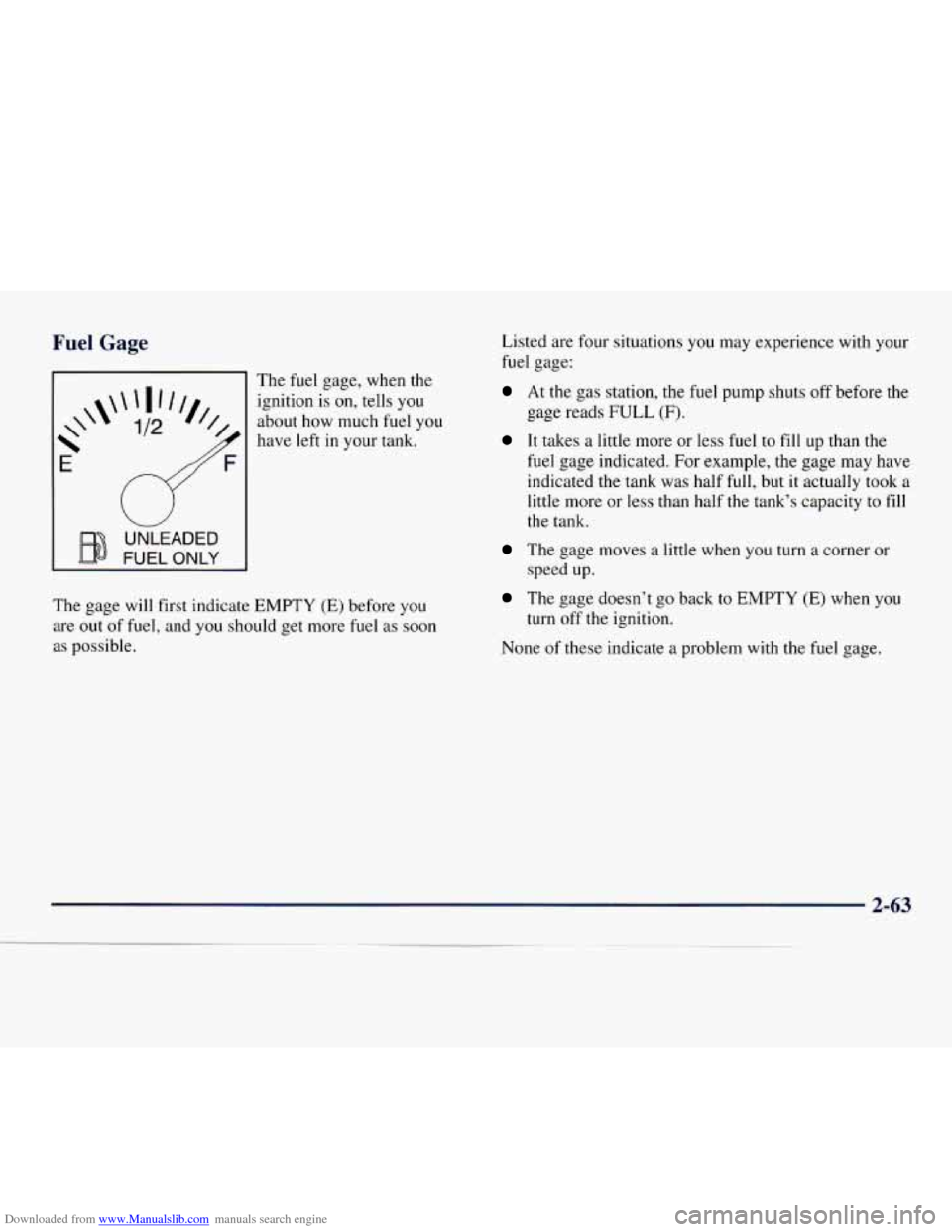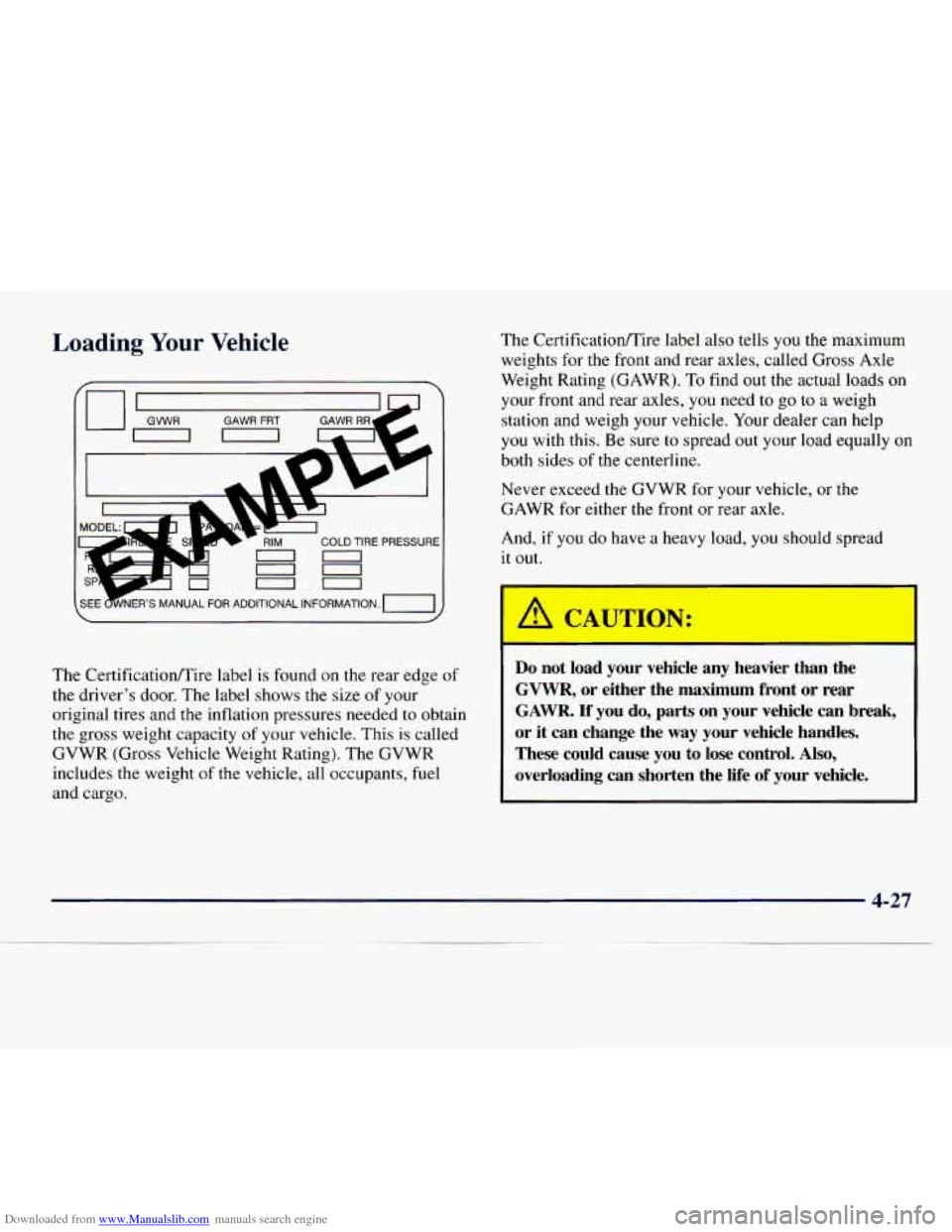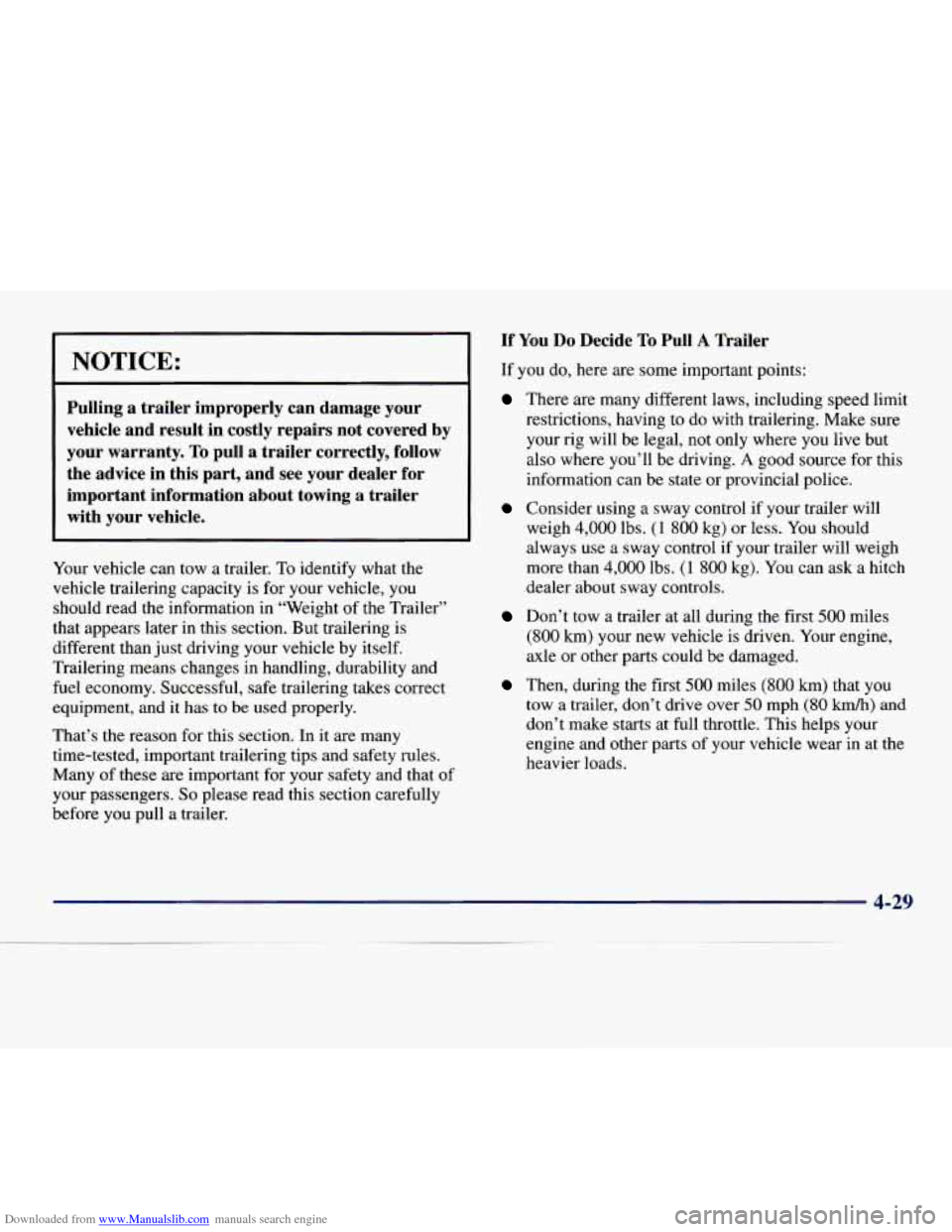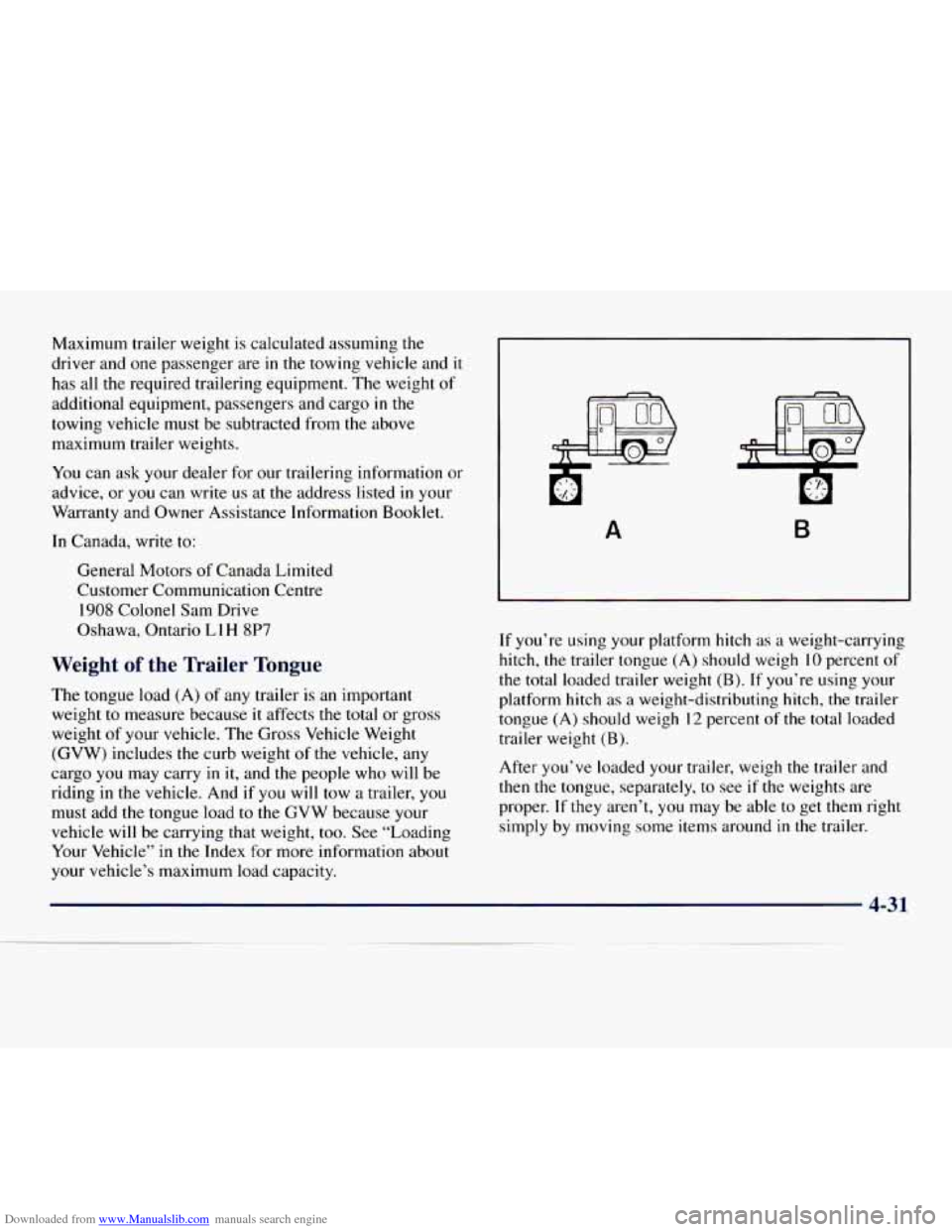1998 CHEVROLET EXPRESS load capacity
[x] Cancel search: load capacityPage 134 of 386

Downloaded from www.Manualslib.com manuals search engine .~ 1 Gage
\\'
E
FUEL ONLY UNLEADED
The
fuel gage, when the
ignition is
on, tells you
about how much fuel you
have left in your tank. Listed are
four situations you may experience with your
fuel gage:
At the gas station, the fuel pump shuts off before the
gage reads FULL
(F).
It takes a little more or less fuel to fill up than the
fuel gage indicated. For example, the gage may have
indicated the tank was half full, but
it actually took a
little more or less than half the tank's capacity
to fill
the tank.
The gage moves a little when you turn a corner or
speed up.
The gage will first indicate EMPTY
(E) before you
are out of fuel, and you should get more fuel as soon
as possible.
The gage doesn't go back to EMPTY (E) when you
turn off the ignition.
None
of these indicate a problem with the fuel gage.
2-63
Page 190 of 386

Downloaded from www.Manualslib.com manuals search engine Loading Your Vehicle
COLD TIRE PRESSURE
The Certificationrnire label is found on the rear edge of
the driver's door. The label shows the size
of your
original tires and the inflation pressures needed to obtain
the gross weight capacity of your vehicle. This is called
GVWR (Gross Vehicle Weight Rating). The GVWR
includes the weight of the vehicle, all occupants, fuel
and cargo. The
Certificatioflire label also tells you the maximum
weights for the front and rear axles, called
Gross Axle
Weight Rating (GAWR).
To find out the actual loads on
your front and rear axles, you need to go to a weigh
station and weigh your vehicle. Your dealer can help
you with
this. Be sure to spread out your load equally on
both sides of the centerline.
Never exceed the GVWR for your vehicle, or the
GAWR
for either the front or rear axle.
And, if you do have a heavy load, you should spread
it out.
I
I
A QUI 0 :
Do not load your vehicle any heavier than the
GVWR, or either the maximum front or rear
GAWR. If you do, parts on your vehicle can break,
or
it can change the way your vehicle handles.
These could cause you to lose control.
Also,
overloading can shorten the life of your vehicle.
4-27
Page 192 of 386

Downloaded from www.Manualslib.com manuals search engine I NOTICE:
Pulling a trailer improperly can damage your
vehicle and result in costly repairs not covered by
your warranty.
To pull a trailer correctly, follow
the advice in this part, and see your dealer for important information about towing a trailer
with your vehicle.
Your vehicle can tow a trailer. To identify what the
vehicle trailering capacity is for your vehicle, you
should read the information in “Weight of the Trailer”
that appears later in this section. But trailering is
different than just driving your vehicle by itself.
Trailering means changes in handling, durability and
fuel economy. Successful, safe trailering takes correct
equipment, and it has to be used properly.
That’s the reason for this section. In it are many
time-tested, important trailering tips and safety rules.
Many of these are important for your safety and that
of
your passengers. So please read this section carefully
before you pull a trailer.
If You Do Decide To Pull A Trailer
If you do, here are some important points:
There are many different laws, including speed limit
restrictions, having to do with trailering. Make sure
your rig will be legal, not only where you live but
also where you’ll be driving.
A good source for this
information can be state or provincial police.
Consider using a sway control if your trailer will
weigh
4,000 lbs. (1 800 kg) or less. You should
always use a sway control
if your trailer will weigh
more than
4,000 lbs. (1 800 kg). You can ask a hitch
dealer about sway controls.
Don’t tow a trailer at all during the first 500 miles
(800 km) your new vehicle is driven. Your engine,
axle or other parts could be damaged.
Then, during the first 500 miles (800 km) that you
tow a trailer, don’t drive over 50 mph (80 kmh) and
don’t make starts
at full throttle. This helps your
engine and other parts of your vehicle wear
in at the
heavier loads.
4-29
Page 194 of 386

Downloaded from www.Manualslib.com manuals search engine Maximum trailer weight is calculated assuming the
driver and
one passenger are in the towing vehicle and it
has all the required trailering equipment.
The weight of
additional equipment, passengers and cargo
in the
towing vehicle must be subtracted from
the above
maximum trailer weights.
You can ask your dealer for our trailering information or
advice, or you can write
us at the address listed in your
Warranty and Owner Assistance Information Booklet.
In Canada, write to:
General Motors
of Canada Limited
Customer Communication Centre
1908 Colonel Sam Drive
Oshawa, Ontario
L 1 H 8P7
Weight of the Trailer Tongue
The tongue load (A) of any trailer is an important
weight to measure because
it affects the total or gross
weight of your vehicle. The Gross Vehicle Weight
(GVW) includes the curb weight of the vehicle, any
cargo you may carry in
it, and the people who will be
riding in the vehicle. And if
you will tow a trailer, you
must add the tongue load to the GVW because your
vehicle will be carrying that weight,
too. See “Loading
Your Vehicle” in the Index for more information about
your vehicle’s maximum load capacity.
A B
If you’re using your platform hitch as a weight-carrying
hitch,
the trailer tongue (A) should weigh 10 percent of
the total loaded trailer weight
(B). If you’re using your
platform hitch as a weight-distributing hitch, the trailer
tongue
(A) should weigh 12 percent of the total loaded
trailer weight
(B).
After you’ve loaded your trailer, weigh the trailer and
then
the tongue, separately, to see if the weights are
proper. If they aren’t, you may be able to get
them right
simply by moving some items around
in the trailer.
Page 252 of 386

Downloaded from www.Manualslib.com manuals search engine Checking Engine Oil
Pull out the dipstick and clean it with a paper towel or
cloth, then push it back in all the way. Remove it again,
keeping the tip down, and check the level.
When to Add Engine Oil
If the oil is at or below the ADD mark, then you’ll need
to add at least one quart of oil. But you must use the
right kind. This part explains what kind
of oil to use. For
crankcase capacity,
see “Capacities and Specifications”
in the Index.
NOTICE:
Don’t add too much oil. If your engine has so
much oil that the oil level gets above the upper
mark that
shows the proper operating range,
your engine could be damaged.
The engine oil filler cap is located between the coolant
recovery tank and
the air cleaner.
Page 288 of 386

Downloaded from www.Manualslib.com manuals search engine Wheel Replacement
Replace any wheel that is bent, cracked, or badly
rusted or corroded. If wheel nuts keep coming loose,
the wheel, wheel bolts and wheel nuts should be
replaced. If the wheel leaks air, replace it (except
some
aluminum wheels, which can sometimes be repaired).
See your dealer if any
of these conditions exist.
Your dealer will know the kind of wheel
you need.
Each new wheel should have the same load-carrying
capacity, diameter, width, offset and be mounted the
same way as the one it replaces.
If
you need to replace any of your wheels, wheel bolts
or wheel nuts, replace them only with new
GM original
equipment parts. This way, you will be sure to have the
right wheel, wheel bolts and wheel nuts for your vehicle.
I A CAUTION:
Using the wrong replacement wheels, wheel
bolts or wheel nuts on your vehicle can be
dangerous. It could affect the braking and
handling
of your vehicle, make your tires lose
air and make you lose control. You could have
a collision in which you or others could be
injured. Always use the correct wheel, wheel
bolts and wheel nuts for replacement.
I NOTICE:
The wrong wheel can also cause problems with
bearing life, brake cooling, speedometer or
odometer calibration, headlamp aim, bumper
height, vehicle ground clearance and tire or tire
chain clearance to the body and chassis.
Page 307 of 386

Downloaded from www.Manualslib.com manuals search engine Cooling System Capacity (Approximate)
ENGINE VIN QTY Without Rear Heater
“VORTEC”4300 W 1 1 Quarts ( 10.4 L)
“VORTEC”5000 M 17 Quarts (16 L)
“VORTEC”5700 R 17 Quarts (1 6 L)
“VORTEC”7400 J 23 Quarts (2 1.8 L)
QTY With Rear Heater
14 Quarts (13.2 L)
20 Quarts (18.9 L)
20 Quarts (18.9 L)
26 Quarts (24.6 L)
After refill, the level MUST be checked as outlined under “Engine Cooling System” in Section 5.
Crankcase Capacity (Approximate)
ENGINE VIN Quantity With Filter
“VORTEC”4300 W 4.5 Quarts (4.3 L)
“VORTEC”5000 M 5 Quarts (4.8 L)
“VORTEC”5700 R 5 Quarts (4.8 L)
“VORTEC”7400 J 6.6 Quarts (6.24 L)
After refill, the level MUST be rechecked. Add enough engine oil so that the fluid is within the proper operating
range. See “Engine Oil” in the Index.
*Add one additional quart for RPO 5Z1 and
RPO KL5 Models.
6-68
Page 308 of 386

Downloaded from www.Manualslib.com manuals search engine Fuel Tank Capacity (Approximate)
TYPE QUANTITY
Standard Tank 31 Gallons (117.33 L)
Standard Tank 33 Gallons (124.90 L)
Optional Tank* 55 Gallons (208.18 L)
** 159”, 177” Wheelbase Vehicles Only.
MODEL TYPE
Passenger and Cargo
Cab and Chassis
Cab and Chassis
Normal Maintenance Replacement Parts
Engine “VORTEC”4300 “VORTEC”5000
VIN W M
Oil Filter PF52 PF1218
Air Cleaner Filter
* A917C A9 17C
PCV Valve CV789C cv774c
Spark
Plugs 4 1-932 4 1-932
Fuel Filter GF48
1 GF48 1
Radiator Cap RC36 RC36
“VORTEC”5700
R
PF1218
A917C
cv774c 4 1-932
GF48
1
RC36
“VORTEC”7400
J
PF1218 A917C
cv774c 4 1-932
GF48
1
RC36
* Replace with AC Air Filter, Part No. A917C and for severe dusty conditions, use AC Air Filter, Part No. 1236C.